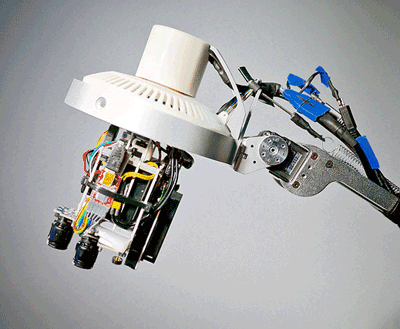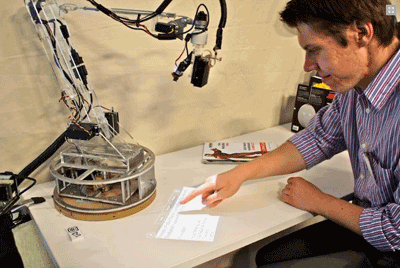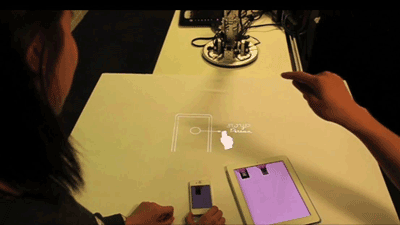Hacked lamp turns ordinary tabletop into touchscreen computer
Entire computer can be screwed into light socket, projects interactive images onto nearby surface
Here’s something you don’t get to write every day: students have hacked a desktop lamp and turned it into a computer. Surprising? Yes. Not so surprising — the students are from M.I.T.

The LuminAR (Image via: technologyreview.com)
Natan Linder, a student at MIT’s Media Lab, in working with his fellow classmates, has created a device called LuminAR. Basically, it’s a Wi-Fi-based robotic computer system that gets screwed into any standard light bulb socket. It includes a camera, sensor technology, and specially written software to tell the LuminAR what objects are nearby. It also includes a Pico-projector for the purpose of turning nearby surfaces into touchscreen computers.

Users can interact with the LuminAR on a variety of surfaces.
The LuminAR runs on the same Qualcomm Snapdragon processor typically found in today’s mobile computing systems. The team is experimenting with creating their own Linux-based operating system while also trying out a modified version of Google’s Android mobile operating system.
The device is built around gesture control, which allows the user to select programs to open, adjust the position of the screen, or change the size of the projection. Additionally, swipe gestures are used to transfer content between touch-enabled devices and the LuminAR.

A simple swipe motion allows the user to transfer data between touch devices and the LuminAR.
The unique spelling of the product — LuminAR — is purposeful. You see, Linder describes the device as an augmented-reality system because the images and interfaces it projects alter the function of a surface or object, thus bridging the divide between digital and physical interactions.
While it might seem like a novelty gadget, LuminAR does present plenty of unique uses. It could be used to project price tags next to objects for sale or buttons that could be used to call up more information about a product, act as the medium for Skype-like video calls, and more, all of which is explored in the video below:
Story via: media.mit.edu
■
Advertisement
Learn more about Electronic Products Magazine






